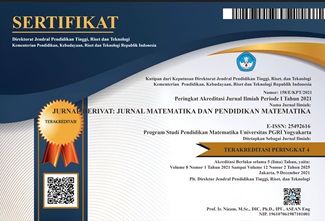Kecemasan Matematika Siswa Ditinjau Dari Hasil Belajar
DOI:
https://doi.org/10.31316/jderivat.v10i1.4540Abstract
Abstract
Mathematics is a subject that is quite difficult for students. Many students feel anxious when faced with math problems. The purpose of this study was to determine the level of math anxiety possessed by students based on their learning outcomes. This research is a descriptive qualitative research with 62 junior high school students representing each category of anxiety as subjects. Data collection techniques in this study include observation, questionnaires, interviews, and tests. The results of the study show that the math anxiety experienced by students in solving flat-sided geometrical problems consists of 4 levels of anxiety, namely the category of no anxiety as many as 8 students or 13%, the category of mild anxiety as many as 34 students or 55%, the category of moderate anxiety as many as 18 students or 29%, severe anxiety category as many as 2 students or 3%. Overall, students’ mathematical anxiety in solving problems on solid shapes topi was in low category with the average score of test result is 38,18 which is in opor category.
Keywords: Learning Outcome, Mathematics Anxiety
References
Ashcraft, M. H. (2019). Models of math anxiety. In I. . Mammarella, S. Caviola, & A. Dowker (Eds.), Mathematics Anxiety: What is Known and What is Still Missing (1st ed.). Routledge. https://doi.org/https://doi.org/10.4324/9780429199981
Cipora, K., Santos, F. H., Kucian, K., & Dowker, A. (2022). Mathematics anxiety—where are we and where shall we go? Annals of the New York Academy of Sciences, 1513(1), 10–20. https://doi.org/https://doi.org/10.1111/nyas.14770
Fauzi, I., & Arisetyawan, A. (2020). Analisis kesulitan belajar siswa pada materi geometri di sekolah dasar. Kreano, Jurnal Matematika Kreatif-Inovatif, 11(1), 27–35. https://doi.org/https://doi.org/10.15294/kreano.v11i1.20726
Hamilton, M. R. (1959). The assessment of anxiety scales by rating. British Journal of Medical Psychology, 32, 50–55.
Hidayah, N., & Atmoko, A. (2014). Landasan Sosial Budaya dan Psikologis Pendidikan: Terapannya di Kelas. Malang: Gunung Samudera.
Hunt, T. E., & Maloney, E. A. (2022). Appraisals of previous math experiences play an important role in math anxiety. Annals of the New York Academy of Sciences, 1515(1), 143–154. https://doi.org/https://doi.org/10.1111/nyas.14805
Klee, H. L., Buehl, M. M., & Miller, A. D. (2022). Strategies for alleviating students’ math anxiety: Control-value theory in practice. Theory Into Practice, 61(1), 49–61. https://doi.org/10.1080/00405841.2021.1932157
Kusumawati, R., & Nayazik, A. (2017). Kecemasan matematika siswa SMA berdasarkan gender. Journal of Medives, 1(2), 92–99.
Lau, N. T. T., Hawes, Z., Tremblay, P., & Ansari, D. (2022). Disentangling the individual and contextual effects of math anxiety: A global perspective. Proceedings of the National Academy of Sciences, 119(7), e2115855119. https://doi.org/10.1073/pnas.2115855119
Mamolo, L. A. (2021). Development of an Achievement Test to Measure Students’ Competency in General Mathematics. Anatolian Journal of Education, 6(1), 79–90. https://doi.org/10.29333/aje.2021.616a
May, D. K. (2009). Mathematics self-efficacy and anxiety questionnaire. University of Georgia Athens.
Nabillah, T., & Abadi, A. P. (2019). FAKTOR PENYEBAB RENDAHNYA HASIL BELAJAR SISWA. Prosiding Sesiomadika, 2(1c). Retrieved from https://journal.unsika.ac.id/index.php/sesiomadika/article/view/2685
Noto, M. S., Priatna, N., & Dahlan, J. A. (2019). Mathematical Proof: The Learning Obstacles of Preservice Mathematics Teachers on Transformation Geometry. Journal on Mathematics Education, 10(1), 117–126.
Nursalam. (2014). Metodologi Penelitian Ilmu Keperawatan: Pendekatan Praktis. Surabaya: Salemba Medika.
Sule, B., Hussaini, M. M., Bashir, U. S., & Garba, A. (2016). Mathematics phobia among senior secondary school students: implication for manpower development in science education in Nigeria. International Journal of Education and Evaluation, 2(8), 16–21.
Utari, D. R., Setia, W. M. Y., & Damayani, A. T. (2019). Analisis kesulitan belajar matematika dalam menyelesaikan soal cerita. Jurnal Ilmiah Sekolah Dasar, 3(4), 534–540. https://doi.org/https://doi.org/10.23887/jisd.v3i4.22311
Weissgerber, S. C., Grünberg, C., Neufeld, L., Steppat, T., & Reinhard, M.-A. (2022). The interplay of math anxiety and math competence for later performance. Social Psychology of Education, 25(4), 977–1002. https://doi.org/10.1007/s11218-022-09700-y
Downloads
Published
Issue
Section
Citation Check
License
Copyright (c) 2023 Danu Nugroho, Zainuddin Untu, Auliaul Fitrah Samsuddin

This work is licensed under a Creative Commons Attribution-ShareAlike 4.0 International License.
Authors who publish with this journal agree to the following terms:
-
Authors retain copyright and grant the journal right of first publication with the work simultaneously licensed under a Creative Commons Attribution-ShareAlike 4.0 International License that allows others to share the work with an acknowledgment of the work's authorship and initial publication in this journal.
- Authors are able to enter into separate, additional contractual arrangements for the non-exclusive distribution of the journal's published version of the work (e.g., post it to an institutional repository or publish it in a book), with an acknowledgment of its initial publication in this journal.
- Authors are permitted and encouraged to post their work online (e.g., in institutional repositories or on their website) prior to and during the submission process, as it can lead to productive exchanges, as well as earlier and greater citation of published work (See The Effect of Open Access).







